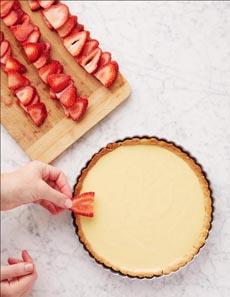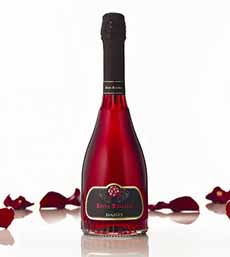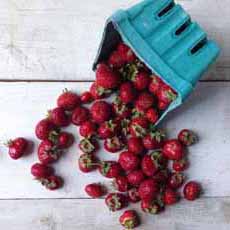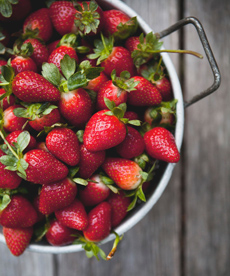TIP OF THE DAY: Strawberry Tart For Valentine’s Day
|
Red Velvet is a subscription service in New York City that breaks down any resistance to home baking, by delivering kits that contain everything you need to bake the featured dessert.
There’s no need to measure anything; just stir to mix. We took inspiration from their photos (#1 and #2) to make a lovely strawberry “flower” tart , a happy pairing of strawberries and crème pâtissière. It’s a spot-on dessert for Valentine’s Day, or any other festive occasion. Crème pâtissière (CREHM pah-tis-YAIR) is called pastry cream in the U.S. and confectioner’s custard in the U.K. It’s a stirred custard—egg yolks and sugar blended with milk and/or cream. It’s thickened with cornstarch or flour and typically flavored with vanilla, although other flavors can be used (citrus, cocoa and coffee are popular). It’s used to fill éclairs, napoleons, and other pastries; as the base for tarts and flans; and to fill cakes, including génoise (sponge cakes). With the addition of beaten egg whites, it becomes crème Saint-Honoré, a filling for cream puffs. It’s added to buttercream to make mousseline filling for other cakes and pastries. Crème pâtissière is the same basic recipe as crème anglaise, but the addition of the starch gives it the stability to be brought to a boil. Crème anglaise is used in sauce form. Custard as we know it dates back to the Middle Ages, when it was used as a filling for a flan or a tart. The word custard is derived from “crustade,” a tart with a crust. After the 16th century, fruit creams became popular and it was about this time that custards began to be made in individual dishes or bowls rather than as fillings for a crust. Set custards were more difficult to make than custard sauces. A cook couldn’t effectively use a water bath in the fireplace, plus it was difficult to check the “doneness” of the custards over the old open fires. By the 17th century, set custards had become popular thanks to ovens, which enabled delicate baking, including crème brûlée: custard topped with burnt sugar (the earliest recipe known is French, from 1692 [source]. Today custard is used to fill tarts, Danish pastry, flans, cream puffs and éclairs; it is mixed into trifles and otherwise part of other sweet and savory delights. Take a look at the different types of custard. |
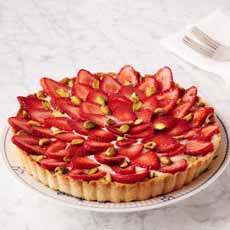 Tilting the strawberry slices instead of lying them flat on the custard achieves a flower effect (both photos courtesy Red Velvet | NYC).
|
|
|
This recipe, adapted from Chowhound, has a little something extra: citrus-accented pastry cream instead of the conventional vanilla. If you prefer, substitute vanilla for the citrus zest. Ingredients For The Crust |
||
|
|
Preparation 1. PREHEAT the oven to 350°F with a rack in the middle. Make the crust: Blend the flour, butter, sugar and salt in a food processor until moist crumbs form (this can take up to 1 minute). 2. TRANSFER the dough to the tart pan, flower your fingers, and press the dough evenly into pan and up sides. Flour the bottom of a measuring cup and use it to press the dough firmly into bottom and against sides of pan. Freeze the crust for 10 to 15 minutes, until firm. 3. PRICK the crust all over with a fork. Bake until golden, 25 to 30 minutes, pressing down gently once or twice with a spoon during baking if crust puffs up (or, use dried beans or pie weights). Cool completely in the pan. 4. MAKE the crème pâtissière. Place the milk, vanilla pod and vanilla seeds in a medium saucepan. Cook over medium heat until the milk comes just to a simmer. Remove from the heat. Meanwhile… 5. PLACE the sugar and egg yolks in a medium heatproof bowl and beat until incorporated. Set a fine-mesh strainer over the egg mixture; place the cornstarch and flour in the strainer and sift them into the egg mixture. Remove the strainer and stir to combine. Wash and dry the strainer and place it over a second medium heatproof bowl; set aside. 6. REMOVE and discard the vanilla pod from the milk. While whisking constantly, slowly add all of the milk to the egg mixture. 7. RETURN the mixture to the saucepan and place it over medium-low heat. Whisk constantly until the mixture thickens, about 2 to 3 minutes. Whisk constantly, scraping the bottom of the pan with the whisk, or the eggs will curdle. When the whisk is scraped across the bottom of the pan, it should leave a clear line. Immediately remove from the heat. 8. USE a rubber spatula to transfer the pastry cream to the strainer; stir until completely strained, leaving any solids behind. Scrape the cream clinging to the underside of the strainer into the bowl and discard the solids left inside. Add the butter and stir until melted and smooth. Stir in the citrus zests and salt. |
|
|
9. PRESS a sheet of plastic wrap directly onto the surface of the pastry cream to prevent a skin from forming. Refrigerate until chilled, at least 2 hours. 10. WASH and dry the strawberries thoroughly and set aside until ready to assemble. Just before assembling, hull the berries and slice them 1/4 inch thick. Move the smaller pieces to the side; you’ll hopefully have enough even-size slices. Check the sweetness of the berries. If they need a bit more, sprinkle them with a bit of sugar. 11. TAKE the pastry cream from the refrigerator, whisk until smooth, and spread in an even layer into the cooled crust. Starting from the outside and working your way to the center of the tart, evenly shingle the strawberries at a slant with the tops in the pastry cream (photo #2). The pointed ends should be angled slightly up. Place them in an overlapping circular pattern. 12. REFRIGERATE until ready to serve.
|
||
